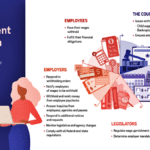Estimated reading time: 6 minutes
(Editor’s Note: Today’s article is brought to you by our friends at ADP, a comprehensive global provider of cloud-based human capital management solutions. Industry analyst firm Nelson Hall recently identified ADP as a leader in both the small and medium business as well as mid to large market segments. Congrats to them! Enjoy the read.)
Some people might look at the title of today’s article and say, “Wage garnishments? That’s the payroll department. Not HR.” And you’re right. Payroll departments do handle the processing of wage garnishments.
But make no mistake, when employees have a question about their paycheck, including deductions like a wage garnishment, the first place they often go is HR. We need to know how to answer questions and support payroll processing. It’s never good when an employee’s paycheck is incorrect. Especially during a time when voluntary quits are at an all-time high.
Wage garnishments happen more often than you might think
In the ADP Research Institute white paper “The U.S. Wage Garnishment Landscape: Through the Lens of the Employer”, they report that one in 14 U.S. employees is subject to some form of wage garnishment. The most common type of garnishment is for child support (50%+). Tax levies is second at around 19% and bankruptcy orders are third at 5%. The report also indicated that the highest number of wage garnishments are employees between the ages of 35 and 54. This group also has the highest wage garnishment rate (approx. 10%).
The reason I want to talk about wage garnishments today is because I believe that remote and hybrid work is bringing a whole new level of complexity when it comes to processing garnishments. And that complexity often comes with risks for employers that could translate into penalties and interest or being liable for full amount of the garnishments if not done compliantly.
Organizations have employees working all over the place. Don’t get me wrong. That’s a good thing. But it means that HR and payroll departments have to think about all the different state laws where their employees are working. When it comes to processing wage garnishments, states have different laws in this area as well. So, there’s a potential increased risk of making a mistake managing wage garnishments.
Wage Garnishments: Different states have different laws
I wanted to gain some understanding of the different ways that states legislate wage garnishments. So, I spoke with Corri Flores, director of government affairs in ADP’s wage garnishments global money movement and compliance division. Corri shared three examples that highlighted where organizations need to focus their wage garnishment compliance efforts.
#1 – TIMING. Different states have different requirements when it comes to the deadline to remit payment after the paycheck deduction occurs. For example, in California, the employer must remit the payments withheld by the 15th of the next month after each payday or if the employer wishes to pay more frequently than monthly, each payment must be made within 10 days after the close of the pay period.
But if you’re processing a Kentucky garnishment, the employer is ordered to remit the payments after each pay period. And in Florida, the employer is required to withhold the payments from each paycheck, but then hold them until they receive an order to pay the amount (issued by the court). This can be a huge burden for the employer to withhold and sit with the payment for a period of time until the order to release the funds is received.
#2 – QUANTITY. There are variances in whether a state allows for multiple creditors’ garnishments against the employees’ wages. For example, Colorado only allows one creditor garnishment to be processed against an employee’s wages at a time. If an employer is already withholding on a creditor garnishment for an employee and receives a second one, they would not be able to set up the second creditor garnishment.
However, Georgia allows multiple creditor garnishments to be withheld from an employee’s wages up to the maximum allowable withholding limits. If a Georgia employer receives 4 creditor garnishments, all 4 could potentially be set up.
#3 – DEDUCTION LIMITS. The maximum amount withheld in an employee’s pay can vary by state. Oh, and federally as well.
Many states follow the federal guidelines of only allowing the creditor to garnish a weekly amount not to exceed the lesser of 25% of the employee’s disposable earnings, or the amount by which an employee’s disposable earnings are greater than 30 times the federal minimum wage (currently $7.25 an hour). Arkansas is one of the states that follows the federal maximum limitations on creditor garnishments.
However, some states allow for more of the wages to be protected from garnishments than what federal guidelines allow. Then, when there are variances between the federal protection and state, employers are instructed to use the law that results in the lower amount of earnings being garnished. Massachusetts passed legislation to protect more of the employee’s wages that can be garnished by a creditor to the lesser of 15% of employee’s gross wages per week or the amount by which an employee’s disposable earnings are greater than fifty (50) times the federal or state minimum wage (whichever is higher) per week.
The penalties for mishandled wage garnishments can add up
When it comes to compliance, I know that some organizations take the view that “We’ll just pay the fine.”. As Corri and I were chatting about garnishments, I did ask about penalties. Corri shared the example that Illinois law allows “payors” to be penalized $100 per day if they knowingly fail to withhold child support within 7 days after the date the amount would have been paid. The total penalty amount for a payors failure to withhold per occasion may not exceed $10,000. Failing to pay on more than one occasions creates a presumption that the payor knowingly failed to pay.
Besides the penalties, no organization wants to get the backlash of mishandling employee’s paychecks. Whether that’s from the employee because their garnishment was messed up or from federal or state government because it wasn’t handled according to the law.
Strategic compliance can help manage complexity
Regular readers of HR Bartender know I believe that just because I can do something doesn’t always mean it’s the best use of my time. Wage garnishments are one of those things that fall into this category. Right now, organizations are looking for HR and payroll to focus on employee recruitment, engagement, and retention.
Yes, compliance still needs to be done. Employers must think about how they’re going to maintain compliance, including processing wage garnishments. But HR and payroll departments do not want to spend their time memorizing wage garnishment legislation in every state.
The good news is that with a strategic compliance strategy, technology can assist. And, having a strategic compliance partner – like ADP – can do that for you. Then, HR and payroll can spend their time answering employee questions and making sure that employees know their garnishments are being handled properly and legally. This is an opportunity to reduce risk and be more labor efficient.
P.S. If you want to learn more about creating a wage garnishment management process, I hope you’ll listen to the discussion Corri and I had on “Transforming Wage Garnishment Compliance”. This webinar recording has been approved for recertification credits by the Society for Human Resource Management (SHRM) and the Human Resource Certification Institute (HRCI).
55








